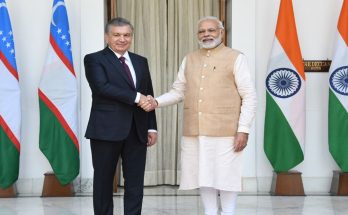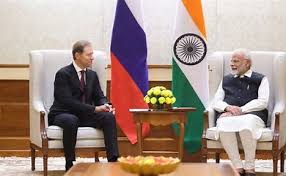 India’s Prime Minister Narendra Modi has launched the “Make in India” initiative, which is aimed at increasing the manufacturing output within India. This is a welcome step towards harnessing India’s large labour force and resource base. However, the manufacturing sector in India has lagged in recent years, and to succeed several reforms are necessary to unlock the potential of India’s manufacturing sector.
India’s Prime Minister Narendra Modi has launched the “Make in India” initiative, which is aimed at increasing the manufacturing output within India. This is a welcome step towards harnessing India’s large labour force and resource base. However, the manufacturing sector in India has lagged in recent years, and to succeed several reforms are necessary to unlock the potential of India’s manufacturing sector.
The protectionist trap
One trap to be avoided is to go in for import restrictions of various kinds, hoping that by doing so domestic manufacturing will rise to meet the demand gap. This would be a short-sighted policy, as domestic products would be insulated against foreign competition, and domestic consumers would be deprived of choices. The result could be higher cost, low quality products which could not be exported. India has faced this situation during the days of the licence-permit raj and nobody would like to go back to it.
Manufacturing: Constraints and roadblocks
What are the obstacles to domestic manufacturing? There are many. Some are – high cost of capital and land, high rates of taxation, lack of technology, rigidity in labour laws, low skill levels of labour, poor infrastructure including power and water supply, poor logistics including inefficient transportation systems for inputs and outputs etc.
These difficulties have already led to Indian entrepreneurs opting for service sector activities, where such issues have a lower impact. Not surprisingly, states such as Gujarat, Maharashtra, and Tamil Nadu which have better infrastructure and access to the sea have done better in manufacturing. China which has better infrastructure has been able to set up manufacturing activities, especially on its Eastern coastal areas. It is not surprising that India has become a world player in services while lagging in manufacturing, while the reverse is the case with China. The situation had become so bad that some Indian corporate had made plans to shift manufacturing activities to other countries around India.
Thus the infrastructure deficit must be bridged in order for “Make in India” to succeed. Power and water supply requires efficient interstate grids and linkages. Efficient logistics and transport linkages to ports on the West and East Coast are essential and require inter-state cooperation. The Centre must encourage development of manufacturing corridors such as the Mumbai-Delhi, Delhi-Kolkata, Kolkata-Mumbai, Mumbai-Chennai and Chennai-Kolkata which could enable the manufacturing sector to develop rapidly.
High cost of capital can be mitigated by interest subsidy for manufacturing, for example. India’s rate of corporate tax of 30% is high compared to the Asian average of 20% and needs to be reduced. Tax holidays and tax reductions, especially for high tech industries will be an incentive. The processes for setting up business should be streamlined. India’s dismal global ranking of 142 in ease of doing business needs improvement.
These changes will stimulate manufacturing by domestic as well as foreign players. In addition, a liberal FDI policy will bring in investment and technology into the manufacturing sector. FDI should be widened to include investment in terms of machinery, equipment, and technology. Exemption from capital gains tax for investments in manufacturing could also provide a stimulus.
Open economy and competition
It is argued that competition and dumping by foreign producers damages Indian manufacturing. However, international competition has to be faced in order to export goods. Therefore, restricting imports is not an effective way to promote the growth of a competitive manufacturing sector. In order to safeguard against dumping and unfair trade practices, timely monitoring of prices of imported products and taking of antidumping actions is necessary. Associations of producers should be encouraged to play an effective role as watchdogs against dumping and unfair trade practices by foreign competitors.
Where it is considered appropriate, the government could provide subsidies of a temporary nature for manufacturing in specific subsectors in order to help them to grow. But the quantum and scope of subsidies must be carefully calibrated and they must be phased out. Subsidies have to be tailored in such a way as not to be contrary of WTO provisions or attract countervailing duties in import markets. Providing subsidies is a last resort measure to be used only when all other efforts to facilitate competitive manufacturing have been exhausted.
Rigidity in Labour Laws
Labour laws in India have become excessively rigid and protective of interests of labour to the detriment of employers. The result has been the reluctance of employers to hire labour, and high rates of unemployment. Political parties have also sought to insert their agendas and interests into the trade unions. This imbalance and rigidity needs to be corrected through tripartite negotiations involving representatives of labour, employers, and government. The spirit of tripartism should be encouraged at the enterprise level. Flexibility in terms of working hours and contract labour should be provided. Such negotiations have been successfully carried out in many countries facing economic challenges.
Skill Development
While India has a large growing young population, it is essential that training and education be provided so that this advantage can be translated into a high quality and skilled labour force. The government has rightly launched a programme of skill development. However, manufacturers’ associations must also play their part so that the correct skills are imparted. Under corporate social responsibility (CSR), support could be provided for such training activities.
Rebooting India’s manufacturing sector is a challenging but essential task. India has a huge potential for manufacturing a wide range of products ranging from traditional and cultural-related products to the most modern sophisticated products. Many of these products have good export potential that can be exploited. The example of the auto sector is a lesson to follow. India has become a major producer and exporter of automotive products including a wide range of 2, 3 and 4 wheelers and components. This has happened as a result of liberalization and integration into the global economy.
The “Make in India” campaign needs the widest possible support to succeed. The central and state governments, business and industry, and labour organizations must work together to achieve this goal.
(Dr. Bhaskar Balakrishnan is a former Ambassador of India. He has worked with UNIDO and ILO and served on the Foreign Investment Promotion Board.)
– This article has been written exclusively for India Writes Network, indiawrites.org. The views expressed in this column are solely those of the author
Author Profile
- India Writes Network (www.indiawrites.org) is an emerging think tank and a media-publishing company focused on international affairs & the India Story. Centre for Global India Insights is the research arm of India Writes Network. To subscribe to India and the World, write to editor@indiawrites.org. A venture of TGII Media Private Limited, a leading media, publishing and consultancy company, IWN has carved a niche for balanced and exhaustive reporting and analysis of international affairs. Eminent personalities, politicians, diplomats, authors, strategy gurus and news-makers have contributed to India Writes Network, as also “India and the World,” a magazine focused on global affairs.
Latest entries
 India and the WorldNovember 26, 2025G20@20: Africa’s Moment – The Once and Future World Order
India and the WorldNovember 26, 2025G20@20: Africa’s Moment – The Once and Future World Order DiplomacyOctober 4, 2025UNGA Resolution 2758 Must Not Be Distorted, One-China Principle Brooks No Challenge
DiplomacyOctober 4, 2025UNGA Resolution 2758 Must Not Be Distorted, One-China Principle Brooks No Challenge India and the WorldJuly 26, 2025MPs, diplomats laud Operation Sindoor, call for national unity to combat Pakistan-sponsored terror
India and the WorldJuly 26, 2025MPs, diplomats laud Operation Sindoor, call for national unity to combat Pakistan-sponsored terror India and the WorldJuly 25, 2025When Fire Ends, Diplomacy Begins
India and the WorldJuly 25, 2025When Fire Ends, Diplomacy Begins







